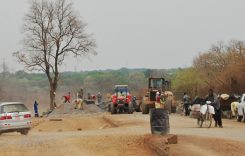Zimbabwe and five other Southern African countries are fighting for exemption from a global ban on ivory trade imposed by the Convention on International Trade in Endangered Species of Wild Fauna and Flora (CITES), saying they must cull their large elephant populations regularly for economic benefit and environmental sustainability.
Researched by Nevanji Madanhire
What is the issue?
CITES banned international trade in ivory in 1989. However, there are still some thriving but unregulated domestic ivory markets in a number of countries, which fuel an illegal international trade. Poaching to meet growing demand from affluent Asian countries is driving up the rate of poaching. In some countries, political unrest contributes to elephant poaching. (www.worldwildlife.org/threats/illegal-wildlife-trade)
The African elephant is still listed as vulnerable on the International Union for Conservation of Nature (IUCN) Red List, according to conservation charity, Tusk. The IUCN moved African elephants from “endangered” to “vulnerable” status in 2004, in part because the animals are relatively numerous and populations are growing in some areas. (WWF)
The Zimbabwe case
The Zimbabwean government is calling for the lifting of the ban on trade in elephants and ivory to allow live sales, culling and trophy hunting and to enable it to sell a stockpile of ivory worth more than half a billion dollars. The proceeds, the country says, will be used to fund the conservation of the animals.
The African elephant is on Appendix 1 and downlisting it to Appendix 2 would allow culling to reduce the population.
In successive meetings held in Botswana and Zimbabwe in May and June, together with other countries in the region which form the (KAZA) bloc, Zimbabwe lobbied for the relaxation of the ban during the inaugural Wildlife Economy Summit aimed at establishing a common position on issues of sustainable wildlife management ahead of a CITES meeting in August 2019 in Geneva.
Angola, Botswana, Namibia, Zambia and Zimbabwe form the Kavango-Zambezi Transfrontier Conservation Area (KAZA TFCA) commonly referred to the KAZA bloc. It is home to more than 250,000 elephants out of the estimated 400,000 elephants worldwide. Zimbabwe boasts 84 000 jumbos, which it says are more than 30,000 too many for the habitat.
The KAZA-bloc countries are making their case at the CITES conference currently being held in Geneva, Switzerland.
Kenya-led opposition
But other African countries, led by Kenya, are opposed to the reopening of international trade in ivory, arguing it will trigger a rise in elephant poaching and endanger further existing populations around the continent.
What is the African elephant?
African elephants are the world’s largest land animals. The African elephant (Loxodonta) is a genus comprising two living elephant species, the larger savannah elephant (Loxodonta africana africana), and the smaller forest elephant (Loxodonta africana cyclotis).
The biggest can be up to 7,5m long, 3,3m high at the shoulder, and 6 tonnes in weight.
The African bush or savannah elephant roams southern African countries including Zimbabwe, Botswana, Zambia, Angola, Namibia and South Africa. The smaller African forest elephant lives in the equatorial forests of central and western Africa the biggest weighing only 2,7 tonnes. (WWF)
How many elephants are in Zimbabwe?
According to the last elephant census done in 2014 Zimbabwe has 82 091 elephants. This translates to 1.5 elephants per km² in the four elephant regions namely North West Matabeleland, Sebungwe, Mid-Zambezi Valley and South East Lowveld. The ideal population should be one jumbo per km².
Zimbabwe’s carrying capacity is 50,000 elephants.
How are they distributed?
Elephants are distributed in four main regional populations in Zimbabwe, namely, Northwest Matabeleland, the Sebungwe, the mid-Zambezi Valley, and the South-East Lowveld. Crude ecological densities vary between 2.16 elephant/km² in Northwest Matabeleland and 0.46 elephant/km² in the Sebungwe region. Elephant densities in the Communal Areas vary from 1.50 elephant/ km² in the south-east Lowveld to 0.06 elephant/km² in the Sebungwe region. Overall it is estimated that 5,000 elephants reside in Communal Areas and occupy approximately 16,000 km².
| Name of Region | Area km² | Estimated Number of Elephants | Density of Elephants/km² |
| Northwest Matabeleland | 24989 | 53 991 | 2.16 |
| Sebungwe | 15529 | 3 407 | 0.22 |
| Mid-Zambezi | 16014 | 11 656 | 0.73 |
| South East Lowveld | 8835 | 13 037 | 1.48 |
Are elephants a threat to their habitat?
An African elephant may eat up to 450kg of vegetation a day, including fruits, flowers from trees, pods, leaves, entire plants and roots. However, their digestive system is not very efficient, so only 40% of this food is properly digested. It drinks up to 400 litres of water a day.
What is its importance to the ecosystem?
The African elephant plays a vital role in maintaining ecological harmony. African elephants ingest plants and fruits, walk for miles, and excrete the seeds in fertile dung piles. In this way, new plants can grow in different areas. Without elephants, the forests would quickly overtake the grasslands. Additionally, they dig watering holes during the dry season, making them vital to many smaller animals. Many animals would die of thirst without them. So the entire ecosystem would suffer greatly by the extinction of elephants. (IUCN)
How has climate change affected the animals?
Periodic droughts reduce vegetation productivity thereby increasing nutritional deficiency which results in an unhealthy population. Calf mortality and mortality of old elephants increases as a result. Mortality is high in the dry season especially in Hwange due to the high temperatures and the lack of perennial rivers; water is supplemented by boreholes.
How sustainable is dependency on borehole water?
Borehole water is a short-term measure to supply much needed water to the large elephant population that is within the park. It is a sustainable option to contain the game water supply. Solar technology has been utilized to ensure efficiency in the pumping of water.
What is the population growth rate?
The annual growth rate of elephants is 5%.
How many people die as a result of human/elephant conflict?
According to Zimbabwe’s National Parks and Wildlife Management Authority, elephants are responsible for 38% of all deaths caused by wildlife in Zimbabwe. Between 2010-2017 more than 200 people lost their lives and others were injured after encountering dangerous animals. Crocodiles and hippopotamus are responsible for most human deaths and injuries but there are many incidents where elephants have killed and maimed people who were tending their fields or traversing wildlife areas.
Are you allowed to cull?
Culling is an elephant management option which can be utilized to control the herds, however this has not been used since the 1980s. The last cull was in 1989 and it was a management plan which had commenced in 1960, during which 45,000 elephants were killed. Different management measures are employed for elephants throughout the region and continent. They range from creation of migration corridors and transfrontier parks and conservation areas (e.g. the Great Limpopo Transfrontier Park and the Greater Mapungubwe and Kavango-Zambezi Transfrontier Conservation Areas), live sales, translocation of animals, creation of artificial waterholes, fencing and deterring animals from crops.
How extensive is the poaching of elephants?
According to CITES, Southern Africa is the only region whose proportion of illegally killed elephants has not risen above 0.5% since 2003. But in February this year (2019) Rangers in Hwange busted a poaching syndicate at Cross Dete leading to the recovery of 96 kg of raw ivory indicating that poaching is still rife. Law enforcement agents have arrested a lot of people for poaching and some have already been convicted. Over the last year (2018) at least 40 poaching syndicates have been busted. The poachers are of several nationalities. Investigations on who is behind the syndicates are ongoing.
Zimbabwe conservation measures?
Zimbabwe says it has various measures in place to deal with poaching problems under the Zimbabwe Parks and Wildlife Management Authority’s Five-year Elephant Management Plan.
This plan is built on the premise that if elephants are to survive in the future, they must have a value, both to the governing authorities and to the local people.
Other management measures employed in the region and continent include the creation of migration corridors and transfrontier parks and conservation areas (e.g. the Great Limpopo Transfrontier Park and the Greater Mapungubwe and Kavango-Zambezi Transfrontier Conservation Areas), live sales, translocation of animals, creation of artificial waterholes, fencing and deterring animals from crops with, for example chilli peppers or beehives, to shooting of problem animals.
Translocation and live sales mainly focus on sub adults because it is scientifically proven that at that age they can easily adapt to new environments.
What are southern Africa’s arguments against the CITES ban?
- CITES is a voluntary organization, so must not give itself a policing role but must be a developmental organization which promotes conservation communities and sustainable utilization of all wildlife resources.
- CITES’ “one-size-fits-all” policy on conservations undermines countries with successful conservation strategies in the KAZA bloc.
- CITES should commend the region for overseeing the growth in elephant population and incentivize conservation by allowing free trade.
- The sale of ivory would help the region maintain good conservation for the next two decades.
- Elephant hunting would help protect communities living next to wildlife.
- According to Zimparks, farmers living near conservation areas have lost more than 7,000 hectares (17,300 acres) of crops to straying elephants.
- The human population is growing and is encroaching onto wildlife areas; renewed trade in elephants would reduce human-wildlife conflict.
What does the pro-ban lobby say?
- Legalising ivory sales benefits the buying countries more than the sellers. Japan and China in 2008 were granted a one-off chance to buy stockpiled ivory from Southern Africa and colluded to keep prices down to just US$150 to 200 per kg leaving the profits to their governments.
- The CITES-sanctioned sale went hand-in-hand with a 71% increase in ivory smuggling.
- Environmental Investigation Agency (EIA), notes that after one-off sales in 1999 and 2008, poaching figures escalated again, as well as incidences of large illegal ivory seizures.
- Having a legal market – albeit only in China and Japan – provided a laundering mechanism for illegal ivory and illegal markets are emerging in other Asian countries.
- Following the 2008 sale, studies indicate that poaching slashed Africa’s savannah elephant population by over 30%.
- Proponents are trying to create the impression that wild populations are growing to problematic numbers when, in fact, the species remains in decline across the continent and is threatened with long-term extinction.
How many elephants has Zimbabwe sold?
Between 2012 and 2018, Zimbabwe sold 98 elephants, mainly to China,raising USD2.7m. Zimbabwe is sitting on a $600m (£470m) cache of ivory that includes rhino horns. (Guardian UK)
What is the value of the world illicit trade in ivory?
Illegal wildlife trafficking is valued at between $7 billion and $23 billion each year. It is the fourth most lucrative global crime after drugs, humans and arms. Only 3% of the fees paid for the hunts reach local communities. Trophy hunting is estimated to create around $200 million in annual revenue. (https://www.weforum.org/agenda/2016/09/fighting-illegal-wildlife-and-forest-trade/)
Do you want to use our content? Click Here












